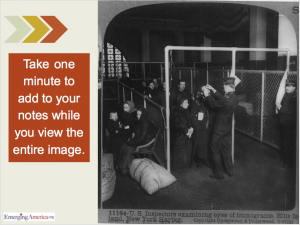In this blog post, we offer a variety of teaching resources, and invite you to plan to join us for the July course “Emerging America: Immigration Issues in Perspective for Diverse Students.”
President Roosevelt, touring Ellis Island
in 1906, watched the people from steerage
line up for their six-second physical….
I imagine
my grandmother, a girl in that Great Hall’s
polyglot, reverberating vault
more terrible than church, dazed by the stars
and stripes in the vast banner up in front….
The Buttonhook, by Mary Jo Salter, in https://poets.org/text/immigration-poems-kids
April, national poetry month, highlights the power of a poem to connect the reader (or listener) to the emotional impact of the content that we teach. In a year when the disruptions of the pandemic have intensified the importance of emotional connection in the classroom, teaching history and social studies with powerful stories has never been more important. Poems, like the one above, can be paired with primary source images like the one below, to spur empathy and inquiry. The poetry collection at poets.org has a rich range to offer.
Ellis Island, New York Harbor, 1913;
https://www.loc.gov/item/97501532/
In a 5-minute NPR story featuring the Immigrant Archive Project, which the Library of Congress recently announced would be among the significant websites archived in their collections, the filmmaker founder described how he was inspired by the the project to collect oral histories from survivors of the Holocaust. (April is also Genocide Awareness Month; find teaching resources here.) As I explored the Immigrant Archive Project website, I was drawn by an account that seemed to me like a prose poem, a creative-non-fiction “letter to my younger self”, linked at the end of this post. See the TPS Teachers Network post about the archive’s resources for links to Library of Congress resources to use in teaching immigrants’ stories, including some highlighted here.
Teaching about history, civics, and current events with immigrants’ stories is a way to build connection with students from a wide variety of backgrounds. Not every family has an immigration story – some families’ roots are from the native communities here for millennia, others’ stories are of forcible relocation, and some don’t know their background – but the personal experience of being new, in a new place, is one that students can identify with. Still, the immigrant experience will connect with more students than you may realize. More than one in four students are multilingual, living in a home where another language is spoken, and with people who are children of immigrants or immigrants themselves. (For more information, see the Accessing Inquiry Know and Support Students page, and US Dept. of Education’s Fast Facts).
Learning that during World War I, nearly one third of Americans were immigrants or children of immigrants can make a meaningful connection to a time over 100 years ago. Immigrant Voices of the Veteran’s History project introduces some of the many personal stories that bring this era to life.
The Library of Congress commissioned radio dramatizations, including “Hidden History, A Story of Immigrants,” in 1941, to be broadcast on by the National Broadcasting Company (NBC). The script, complete with directions for added sound effects, is perfect for an in-class Readers Theater performance, and for student discussion of how and why it was made.
Immigration is, of course, not just a topic of the past. Today, with refugees in the news, and policy on immigration a contentious political topic, introducing immigrant stories from history can provide ways to create safer avenues for discussion of issues (see Accessing Inquiry: Immigrant History through Primary Sources for topics and links to model lessons).
Our summer course, “Emerging America: Immigration Issues in Perspective for Diverse Students,” will provide participants with primary-source rich avenues to engaging students in historical inquiry. We will be joined by a guest speaker, author Jo Napolitano, who covers these topics as they affect classrooms today in her reporting for The 74.
Resources:
- Why Teach Immigrant History? Exploring Language Communities of the U.S.
- Pies, Paintings, and Primary Sources: A Fresh Take on Immigration Studies (teaching ideas)
- Immigration poems at Poets.org.
- Hidden History, A Story of Immigrants, Radio Research Project manuscript collection, 1941 - 1942 - NBC-BBC broadcast script, with roles and background sound cues, for a production of the Library of Congress, dramatizing immigrant stories and calling for Americans to contribute diaries, letters, and documents.
- Letter to my younger self (teaching ideas for using the content below)
Letter to a 14-year-old Maria Concepción Vázquez, when leaving central Mexico in 1962
From blog post by Tony Hernandez, Immigrant Archive Project founder
[side-by-side photos of a young girl and a mature woman]
Dear younger self,
I know you are afraid of leaving your hometown in Michoacán, México to emigrate to the United States. Even though you are coming with your mother, you still feel worried, but there are a lot of things you are going to experience—some good, some bad.
You will sometimes be very timid and at the same time very brave.
You will arrive with your mother in DePue, Illinois, a small town about one hundred miles west of Chicago. You’ll live with your aunt and her family. You’ll be forced to go to school, even though you don’t want to. The first day you attend school, you will feel very strange and out of place. You will feel embarrassed for having to sit there not understanding anything that is going on. You’ll have to depend on a boy to be your interpreter with your teacher for everything you need in the classroom.
The only class you will like is math because you’ll know how to do that. And you’ll like when the teacher calls you by her desk half an hour each day to read with you the Spanish and English book titled El Camino Real because it’s bilingual. These experiences will help you progress...
(Continue at Immigrant Archive Project.)






